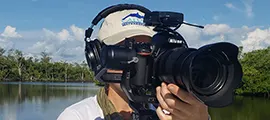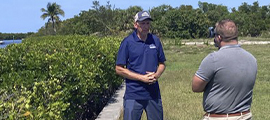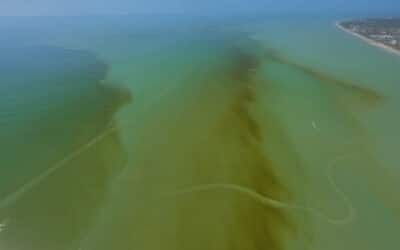Issue:
Stormwater Management

The effects of a rain event from the Caloosahatchee watershed, which often includes Lake Okeechobee discharges.
Stormwater & Nutrient Pollution
As the landscape is cleared for various uses, flood control measures typically create more water quality problems. Stormwater is engineered to run off into canals and waterways much quicker than in the natural systems which allowed for standing water and the filtering of pollutants by wetlands. Ditching, dredging and road building throughout Florida, has altered floways and accelerated runoff in many watersheds. This leads to downstream impacts to receiving waters from stormwater runoff, especially after large rain events.
Stormwater runoff is a dynamic vehicle that introduces many pollutants into our waters, including nitrogen, phosphorous, fecal bacteria, copper, mercury, plastics and more. Whether we’re talking about agricultural or residential uses, the development, fertilization, irrigation and flood control decisions we make on land have a lasting impact on water quality.
Stormwater management and oversight in Florida is a somewhat complex web of government and stakeholder involvement. Land owners, cities, counties and Community Development Districts (CDDs) are all responsible for compliance with the National Pollutant Discharge Elimination System (NPDES) which the state’s Florida Department of Environmental Protection (FDEP) is charged with overseeing. The state’s water management districts also play an important role in flood control projects and stormwater permitting on larger developments.
Many of our other priority issues are related to stormwater loading. For example, Lake Okeechobee discharges are driven by rainfall, carrying legacy nutrients and pollutants. Excess nutrient loading (pollution) of nitrogen and phosphorous are the primary fuel for harmful algal blooms.
When water on our landscape is not allowed time to percolate through the ground or a riparian buffer, it is often inadequately treated in stormwater treatment areas or drained directly into our waterways, taking contaminants with it.
Nutrients & Other Impairments
The Florida Department of Environmental Protection (FDEP) oversees the assessment and verification of impairments to Florida waters. There are a variety of parameters that cause impairments, with the most common being for nutrients (nitrogen or phosphorous), dissolved oxygen, fecal indicator bacteria, turbidity, copper and mercury.
The process of classifying, grouping and assessing our waterbodies is quite laborious and complex. In our view, both the Basin Management Action Plans (BMAP) and accompanying Total Maximum Daily Loads (TMDL) programs, created by the Florida legislature, are largely failing to protect and restore Florida’s impaired waters.
At Calusa Waterkeeper, we are doing our best to independently analyze the state’s stormwater rule-making process, vet local Municipal Separate Storm Sewer System (MS4) permits, identify possible NPDES stormwater violations and hold FDEP and polluters accountable to monitoring requirements and restoration plans.

By the Numbers
Water Quality Trends in SWFL
In 2021, Calusa Waterkeeper began a novel assessment of our local water quality trends using FDEP’s impairment data. This is a relatively comprehensive and unbiased way of determining local water quality trends.
This impairment assessment summary also represents a baseline that can be easily updated from annual FDEP comprehensive verified lists in association with evaluation criteria, such as population growth, that contribute to impairment as presented here. A relatively narrow initial period of record was chosen that would include the latest changes in assessment criteria for added inter-year comparability.
The summary may also provide a basis for evaluating restoration effectiveness by understanding net change in impairment through time.
Read More
Related News Stories
Stormwater
Statement on the Challenge to Remove the Chiquita Lock
The city’s latest request to remove the lock should be denied on many of the same grounds that it was denied on a few short years ago in Administrative Law Judge Francis Ffolkes’ December 2019 ruling.
Red Tide Causes Respiratory Irritation and Hundreds of Thousands of Dead Fish on our Coast – What Can We Do?
For the last several weeks, red tide has brought intense respiratory irritation to beachgoers, hundreds of thousands of dead fish, and several dead sea turtles and dolphin to our beaches.
Pollution Mystery: Where has the Chocolatey Runoff Been Coming From?
Earlier this month, pilot Ralph Arwood, who volunteers for the nonprofit Calusa Waterkeeper, photographed brown billows flowing into the Caloosahatchee from the Townsend Canal in Hendry County, near Lee’s border. Its milk chocolatey color contrasted with the river’s dark blue.
You can Report Trash along the Caloosahatchee that could Pose a Risk to Wildlife
Styrofoam was scattered along the Caloosahatchee riverbank near Centennial Park, and it’s apparently been there for weeks. If you see something, say something, and the city has a way to do just that. If this trash gets into the river or the Gulf of Mexico it’s not going to be good for wildlife.
Construction of Reclaimed Water Pipeline from Fort Myers to Cape Coral to Begin Soon
There’s a plan to keep the water flowing not down a river, but across a river. Progress is happening on an idea to move reclaimed water from Fort Myers to Cape Coral. Caloosahatchee Connect construction will soon start on that pipeline to move water across the Caloosahatchee to be used for irrigation and fire protection.
Lawmakers admit BMAP isn’t working, but they’re not fixing it
Treasure Coast lawmakers admit Florida’s flagship program to reduce water pollution isn’t working. But none are taking action during this legislative session to change it. The BMAP has legally enforceable strategies for landowners to reduce pollution, but Florida isn’t enforcing them beyond warning letters.
Make a Donation
Get Notified
Priority Issues
Harmful Algal Blooms
Cyanobacteria & Red Tide
Cyanobacteria (blue-green algae) and Karenia brevis (red tide) have been making major impacts on Southwest Florida.
Lake Okeechobee Discharges
Revise System Operating Manual
The Caloosahatchee River often suffers from too much freshwater in the wet season, and not enough freshwater in the dry season.
Cape Coral Spreader Canals
Nutrient & Sediment Loading
The City of Cape Coral is working to remove large storm-water barriers to make recreational boating more convenient.
Bacteria Monitoring
Fecal Indicator Bacteria
Calusa Waterkeeper has been at the forefront of monitoring this Fort Myers tributary for fecal bacteria indicators.



































